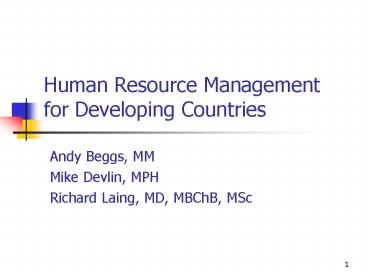Human Resource Management for Developing Countries - PowerPoint PPT Presentation
1 / 20
Title:
Human Resource Management for Developing Countries
Description:
(Note: Optional computer session the following morning. ... Andy Beggs and Mike Devlin. Functional Areas Diagram or 'The Wheel of Management' 17 ... – PowerPoint PPT presentation
Number of Views:98
Avg rating:3.0/5.0
Title: Human Resource Management for Developing Countries
1
Human Resource Management for Developing
Countries
Andy Beggs, MM Mike Devlin, MPH Richard Laing,
MD, MBChB, MSc
2
Human Resource Management for Developing Countries
- Welcome and Faculty Introductions
- What is HRM?
- Course Objectives and Expectations
- Student Introductions
- Review of Course Syllabus
- History of HRM
- Wheels of Management and HRM
- Next Classes
3
What is HRM?
- Michael Beer (HBS)HRM is about the challenges
managers face in developing an effective
organization. An effective organization is one
that producesrequisite levels of HR outcomes
Commitment, Coordination, and Competence.
4
What is HRM?
- WHO DefinitionThe mobilization, motivation,
development and deployment of human beings in and
through work in the achievement of health goals,
which is based on the essential value assumption
that people seekcertain satisfaction from their
work. - Source WHO Training Manual on Management of
Human Resources for Health, 1993.
5
What is HRM?
- Processes related to the life-cycle of people
within an organization. These include defining
jobs, recruiting employees, training,
compensating, motivating, evaluating performance,
developing, and departing. - Source Mike Trisolini, Assistant Professor,
BUSPH.
6
Why is HRM important?
- 1. Health care is heavily people-dependent (up
to 60 - 80 of a national health budget goes to
salaries). - 2. The quality and efficiency of health care
relies on care-givers.
7
Municipal Health Officer with Health Worker and
Assistant Midwife at a Barangay Health Station
(Cavite Province, Philippines)
8
Course ObjectivesAt the conclusion of this
course, students will be able to
- 1. Understand the concepts of HRM in health care.
- 2. Understand the importance of leadership style
to HRM for Health. - 3. Determine staffing needs.
- 4. Utilize HRM assessment skills and create a
plan of action according to your needs. - 5. Implement recruitment and retention
strategies. - 6. Create and implement fair rules and
regulations. - 7. Determine training needs and develop a
training plan. - 8. Provide proper communication with employees
regarding their performance.
9
Course Expectations
- Arrive to class on time.
- Come to class prepared.
- Participate!
- Tailor the course to your workplace needs and
experiences.
10
IH 830 Grading Criteria
- Class participation 20
- -participation and attendance
- Homework submissions 20
- -quality of work and application of concepts
- Issue Paper 30
- -due at start of class on April 24th.
- Issue Paper presentation 10
- Final Case Analysis
20 TOTAL.................................1
00
11
Course Sessions
- 1. Jan 16 - Course Introduction -Andy Beggs and
Mike Devlin - 2. Jan 23 - Motivation and Leadership Styles
- -Andy Beggs
- 3. Jan 30 - Job Design, Selection, Recruitment,
and Orientation. -Mike Devlin and Richard Laing
12
Course Sessions (continued)
- 4. Feb 6 - Supervision and Support (on
Skylab!) -Andy Beggs - 5. Feb 13 - Personnel Management Rules,
Regulations, and Practices - -Andy Beggs
- No Class February 20th (Monday Schedule)
- 6. Feb 27 - Team Building -David Kahler, Ed.D.,
Vice President, World Education - ISSUE PAPER OUTLINE DUE
13
Course Sessions (continued)
- No class on Mar 6 (Spring Recess)
- 7. Mar 13 - Retention and Staff
Development -Michael Devlin, MPH - 8. Mar 20 - HR Planning -Thomas L. Hall, MD,
DrPH Professor, University of California at San
Francisco - (Note Optional computer session the following
morning.) - 9. Mar 27 - Decentralization and HR Development
- - Riitta-Liisa Kolehmainen-Aitken, MD, DrPH
14
Course Sessions (continued)
- 10. April 3 - Performance Planning and
Evaluation -Mike Devlin and Andy Beggs - 11. April 10 - Training -Richard Laing
- 12. April 17 - Problem Solving
- -Andy Beggs and Mike Devlin
15
Course Sessions (continued)
- 13. April 24 - Roundtable Discussion on Human
Resource Management in Health - ISSUE PAPER DUE
- 14 (and 15). May 1 and May 8 -
- HRM Issue Paper Presentations -Andy Beggs,
Mike Devlin, and Richard Laing - 16. May 15 - Final Exam, Course and Paper Review,
and Evaluation -Andy Beggs and Mike Devlin
16
Functional Areas Diagram or The Wheel of
Management
17
Refer to HRM Wheel(attached to handout)
18
Recent History of Management Practice
- Early 1980s
- -Macho Management (tough managers who had a
contemptuous relationship with unions. - Mid 1980s
- -Enlightened Management (need to manage realized
over right to manage, team work, quality circles. - Late 1980s
- -Human Resource Management (focus on commitment,
quality, flexibility, and integration) - Into the 90s
- -Human Resource Development (planning, managing
and supporting workers at strategic policy
levels.) - Simmonds and Bennet Jones (1989).
19
4 Main Features of HRM
- 1. Integration of personnel policies with
strategic or business planning. - 2. Decentralization of responsibility from
personnel/HR departments to line managers. - 3. Shift from management-union relations to
management-employee relations. - 4. Managers as enablers, empowerers and
facilitators.
20
Refer to Figure 1 - Traditional personnel
management vs. human resource management(attached
to handout)

